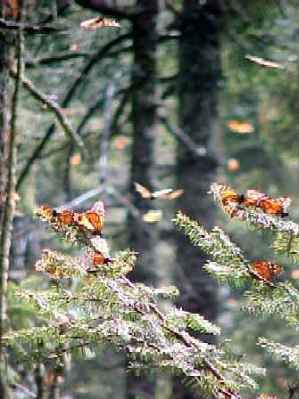We’re privileged in this area of Zihuatanejo to be within an easy day’s drive of the southern extreme of the North American monarch butterfly migration phenomenon that this video features. If you’re here in Zihuatanejo and have the time and inclination for a side trip into the mountains, it is extremely worth the effort to visit the monarch butterfly sanctuaries in the area of Zitacuaro, Michoacan.
Yearly between about October and March, some hundred million monarch butterflies migrate from the northern climes of Canada and the United States-–many over a distance of up to almost 3,000 kilometers, to winter in the mountains of Michoacan, Mexico. The Oyamel trees (sacred firs) favored by these creatures, are hung with such quantities of fluttering orange and black butterflies that the branches themselves become invisible, at times hanging so heavy with their burdens that they break beneath the weight, and the forest whispers with the flutter of millions of diaphanous wings. It’s strange to think that butterflies can be so heavy. The butterflies return year after year to the same winter nesting spots.
El Rosario and Sierra Chincua Monarch Butterfly Sanctuaries
The El Rosario and the Sierra Chincua monarch butterfly sanctuaries in Michoacan, Mexico, are two of the main sanctuaries where this incredible spectacle of nature can be witnessed by the public, and they are both accessible from the small town of Angangueo, Michoacan, slightly to the north of the city of Zitácuaro, close to the border of the state of Mexico.
The sanctuaries are open daily from November through March, 9 a.m. until 6 p.m.
To reach the sanctuaries by car from Zitácuaro, drive north to the town of Ocampo, then carry on to Angangueo. From the Morelia or Patzcuaro side, take the Guadalajara-Mexico City highway to Maravatio, then follow the signs to Aporo and Angangueo. You can park your car in town or in designated parking areas near the sanctuaries, but access to the actual butterfly nesting areas is gained by foot or by horseback over some fairly rough trails. Guides are plentiful both in town and along the roadsides approaching the sanctuaries. The altitude here is above 8,500 feet, so the climb can be arduous in the thin air, The temperature can be close to freezing and is particularly crisp in the underbrush where little sun penetrates. Take sturdy closed shoes or boots for walking in the sanctuary no matter how you plan to get there, and be prepared to bundle up.
Tours can be arranged through a number of travel or tour agencies.
